Fluid Management Systems Market Size and Share
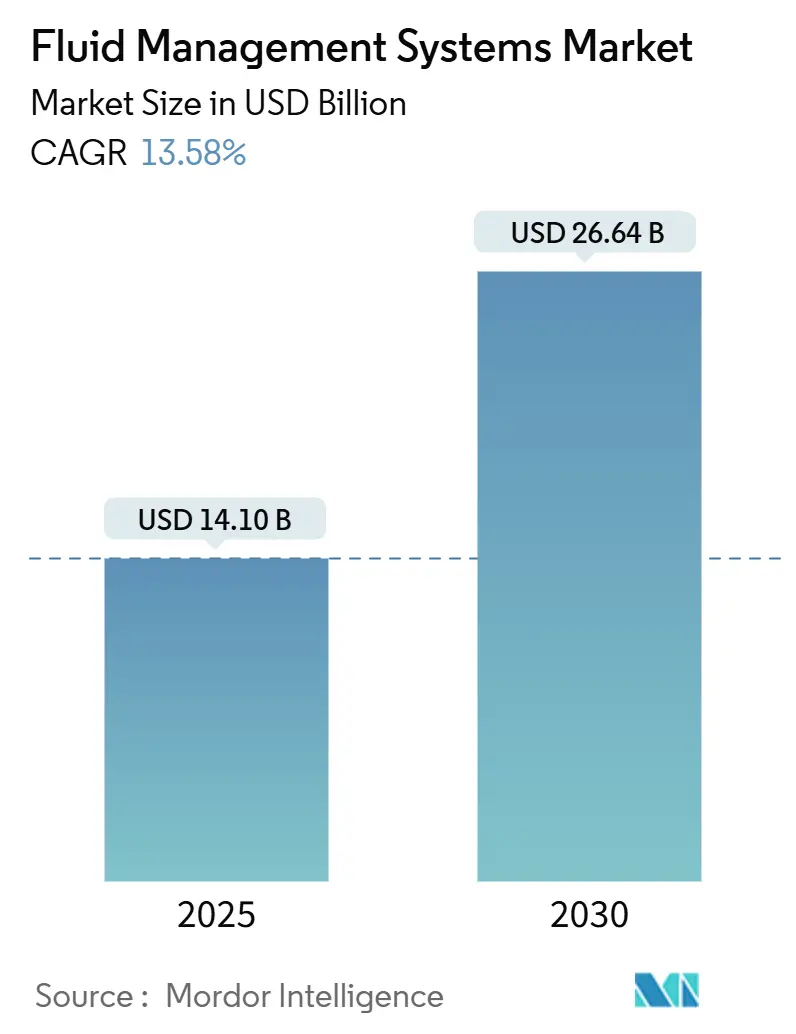
Fluid Management Systems Market Analysis by Mordor Intelligence
The Fluid Management Systems Market size is estimated at USD 14.10 billion in 2025, and is expected to reach USD 26.64 billion by 2030, at a CAGR of 13.58% during the forecast period (2025-2030).
Rapid growth stems from rising minimally invasive surgery volumes, the increasing prevalence of chronic kidney disease, and accelerating adoption of AI-enabled closed-loop ultrafiltration platforms. Hospitals remain the primary purchasers, but home-care adoption is growing fast as portable dialysis devices enable in-home therapies. Competitive dynamics are intensifying as leading vendors bundle hardware, software, and analytics to deliver end-to-end solutions, yet shortages of surgeon talent and supply constraints on medical-grade polymers could temper near-term gains.
Key Report Takeaways
- By product, dialyzers led with 26.78% of fluid management systems market share in 2024; fluid-waste management systems are forecast to grow at a 14.41% CAGR to 2030.
- By disposables, catheters accounted for 33.67% of the fluid management systems market size in 2024, while valves are advancing at a 17.04% CAGR through 2030.
- By application, arthroscopy captured 24.13% share of the fluid management systems market size in 2024; laparoscopy is projected to expand at a 19.17% CAGR between 2025-2030.
- By end user, hospitals held 55.67% of the fluid management systems market share in 2024, whereas home-care settings are growing at a 14.98% CAGR to 2030.
- By geography, North America controlled 41.56% revenue in 2024; Asia-Pacific is the fastest riser with a 14.98% CAGR through 2030.
Global Fluid Management Systems Market Trends and Insights
Drivers Impact Analysis
| Driver | ( ~ ) % Impact on CAGR Forecast | Geographic Relevance | Impact Timeline |
|---|---|---|---|
| Rise in minimally invasive surgery volumes | +2.1% | Global, led by North America & EU | Medium term (2-4 years) |
| Growing prevalence of chronic kidney disease & ESRD | +2.8% | Global, APAC highest growth | Long term (≥ 4 years) |
| AI-enabled closed-loop ultrafiltration control adoption | +1.9% | North America & EU, expanding to APAC | Medium term (2-4 years) |
| Integrated fluid-waste & disposable insufflation systems | +1.4% | Global, regulatory push in EU & North America | Short term (≤ 2 years) |
| Shift toward portable home-dialysis fluid platforms | +2.3% | North America leading | Long term (≥ 4 years) |
| Regulatory push on OR fluid-waste compliance | +1.2% | EU & North America | Short term (≤ 2 years) |
| Source: Mordor Intelligence | |||
Rise in Minimally-Invasive Surgery Volumes
Minimally invasive procedures now dominate many orthopedic and general surgery service lines, increasing demand for irrigation, suction, and insufflation technologies that can maintain clear visibility and stable cavity pressure.[1]Stryker Corporation, “SurgiCount+ System Press Release,” stryker.com Ambulatory surgery centers are standardizing purchasing agreements with med-tech vendors to secure integrated fluid management platforms that streamline workflow and documentation. AI-enhanced devices are further optimizing flow parameters and reducing blood-loss variability. Together, these shifts are enlarging the installed base of high-specification systems in both hospitals and outpatient facilities.
Growing Prevalence of Chronic Kidney Disease & ESRD
Chronic kidney disease affects more than 850 million people worldwide, pushing dialysis procedure volumes higher and requiring new dialyzer membranes with needle-free connectors and bi-directional data feeds.[2]Fresenius Medical Care, “Annual Report 2024,” freseniusmedicalcare.com Hemodiafiltration rollouts in the United States during 2025 promise better toxin clearance, while closed-loop feedback controls have lowered intradialytic hypotension events in 23 of 28 clinical trials. These advancements underpin sustained unit demand for dialysis-specific fluid management platforms across clinics and home settings.
AI-Enabled Closed-Loop Ultrafiltration Control Adoption
Machine-learning algorithms embedded in pumps are predicting hypotension up to 15 minutes before onset and auto-adjusting flow rates, helping clinicians keep relative blood volume within safe ranges 63% of the time during pilot studies.[3]Oxford Academic Journals, “Pilot Study on Ultrafiltration Feedback Control,” academic.oup.com Vendors such as BD now combine hemodynamic monitoring with predictive software to reduce clinician workload and improve consistency in large-scale programs.
Integrated Fluid-Waste & Disposable Insufflation Systems
Regulators are tightening rules on operating-room waste capture, pushing hospitals to invest in platforms that merge delivery, collection, and disposal functions within a single closed loop. B. Braun’s DUPLEX drug-delivery technology trims drug-prep time and medication errors while meeting DEHP-free mandates. Such systems help providers hit environmental, safety, and efficiency targets simultaneously.
Restraints Impact Analysis
| Restraint | ( ~ ) % Impact on CAGR Forecast | Geographic Relevance | Impact Timeline |
|---|---|---|---|
| Shortage of endoscopy-trained surgeons | -1.8% | Global, rural areas hardest hit | Long term (≥ 4 years) |
| High capital cost of integrated platforms | -1.4% | Emerging markets, some developed sites | Medium term (2-4 years) |
| Single-use-plastic legislation inflating consumable costs | -1.1% | EU & North America | Short term (≤ 2 years) |
| Volatile supply of medical-grade polymers & resins | -1.3% | Global, APAC supply nodes | Medium term (2-4 years) |
| Source: Mordor Intelligence | |||
Shortage of Endoscopy-Trained Surgeons
An 18% decline in surgical specialists projected by 2028 is delaying procedure backlogs in many regions. Rural hospitals find it hardest to recruit talent, limiting deployment of advanced endoscopic fluid systems and depressing utilization rates. Rural areas are disproportionately affected by surgeon shortages, limiting access to advanced fluid management technologies and creating geographic disparities in care delivery. The complexity of modern fluid management systems requires specialized training that may not be readily available in all healthcare settings, potentially limiting adoption rates despite technological advancement.
High Capital Cost of Integrated Platforms
State-of-the-art fluid management suites can cost USD 0.5-1.2 million per operating room, a hurdle for lower-tier facilities whose capital budgets are already pressured by inflation and competing IT upgrades. Financing innovations and pay-per-use models are emerging to soften the blow, yet adoption still lags in several emerging economies.
Segment Analysis
By Product: Dialyzers Sustain Leadership
Dialyzers generated 26.78% of 2024 revenue, reflecting the indispensable nature of renal replacement therapy within the broader fluid management systems market. Fresenius Medical Care posted EUR 21.5 billion in 2024 revenue, confirming the resilience of its dialyzer line. Fluid-waste management systems are set to rise at a 14.41% CAGR to 2030, propelled by stricter disposal mandates. Insufflators, suction units, and fluid warmers register steady gains as providers equip minimally invasive theaters with temperature-controlled, smoke-evacuation-ready kits that meet modern safety codes.
The long-tail “other products” bucket comprising AI sensors, cloud dashboards, and modular hubs could shift share toward software-centric vendors if predictive algorithms deliver measurable cost savings. Segment margins vary widely: dialyzer consumables enjoy high recurring revenue, whereas capital-intensive consoles face lengthier replacement cycles, underscoring distinct strategic imperatives within each sub-market.
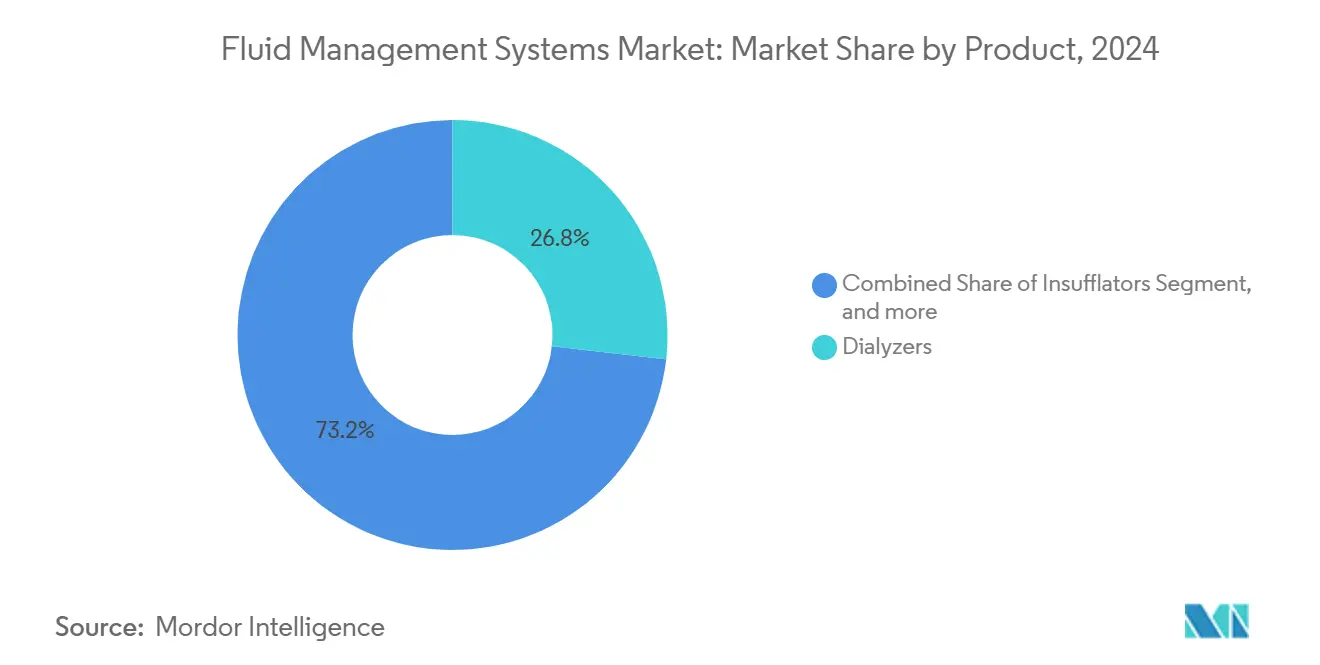
Note: Segment shares of all individual segments available upon report purchase
By Disposables & Accessories: Catheters Dominate Usage
Catheters accounted for 33.67% of 2024 revenues in this category, reflecting universal application in vascular access, irrigation, and drainage across settings. LSI materials, antimicrobial coatings, and kink-resistant geometries differentiate premium SKUs and support hospitals’ infection-control targets. Valves headline future growth with a 17.04% CAGR, mirroring rising demand for automated shut-off and anti-reflux designs that pair seamlessly with smart pumps. Tubing sets and bloodlines represent high-volume staples, but value migration is underway toward integrated kits that bundle pressure sensors and RFID tracking.
Resin price spikes create margin volatility, prompting OEMs to dual-source polymers and redesign packaging to cut plastic weight. As EU legislation ratchets up recyclability thresholds, suppliers that calibrate formulations early could lock in multi-year supply contracts and solidify share positions within the fluid management systems market.
By Application: Arthroscopy Holds Share, Laparoscopy Accelerates
Arthroscopy procedures led with 24.13% revenue share in 2024 and remain core to orthopedic service lines. Visualization fidelity hinges on pristine irrigation control, spurring upgrades to pumps that automatically balance inflow and outflow pressures. Laparoscopy is the fastest-growing application, posting a 19.17% CAGR forecast as bariatric, colorectal, and gynecologic programs expand. Neurology and urology applications also climb as precision irrigation and suction become integral to tumor resection and stone management.
Cardiology relies on high-shear blood pumps and heparinized lines, while dental and gastroenterology segments adopt compact suction-irrigation modules that integrate with standard chairs and scopes. Vendors able to cross-bundle hardware with single-use packs stand to capture incremental procedure volume across diverse specialties within the fluid management systems market size hierarchy.
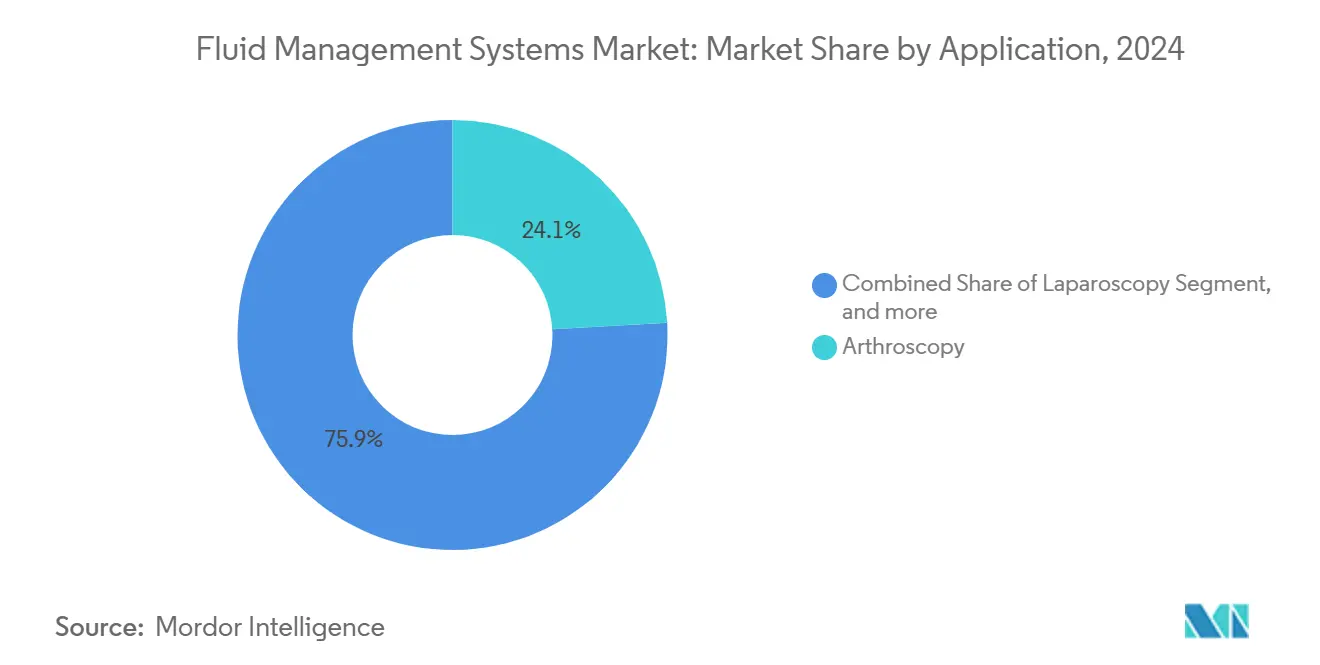
Note: Segment shares of all individual segments available upon report purchase
By End User: Hospitals Remain Primary Buyers
Hospitals capture 55.67% of 2024 expenditure, driven by large theater counts and critical-care units that require multifunction systems. Yet the fastest growth comes from home-care settings, expanding at 14.98% CAGR through 2030 as compact hemodialysis and peritoneal dialysis devices become wearable and connected.
Dialysis centers maintain steady market presence through their specialized focus on renal replacement therapy, with growth driven by increasing chronic kidney disease prevalence and technological advancement in dialysis equipment. Specialty clinics represent a growing segment as healthcare delivery shifts toward specialized care models that require dedicated fluid management systems tailored to specific procedures and patient populations.
Geography Analysis
North America produced 41.56% of 2024 revenues, lifted by robust reimbursement and early adoption of AI monitors. Boston Scientific’s USD 4.663 billion Q1 2025 sales underline the region’s appetite for high-end cardiovascular solutions that rely on precise perfusion control. FDA rule harmonization is expected to streamline multi-site rollouts, though looming surgical workforce shortages could temper growth.
Asia-Pacific is the engine of expansion, advancing at a 14.98% CAGR. China is scaling tertiary hospitals, while India channels public funding into dialysis clinics. Regulatory diversity requires tailored market-access pathways, yet overall device approvals are accelerating as agencies modernize frameworks.
Europe balances maturity with sustainability imperatives. EU directives on post-market surveillance and recyclable packaging are reshaping component design, favoring manufacturers that can verify cradle-to-grave compliance. Meanwhile, decentralization policies in Germany and France bolster outpatient procedure volumes that depend on mobile fluid equipment.
Middle East & Africa and South America trail in absolute size but offer double-digit growth pockets where infrastructure projects align with rising non-communicable disease burdens. Currency fluctuations and import tariffs remain headwinds, pushing suppliers toward local assembly and strategic distributor alliances to penetrate these segments of the fluid management systems market.
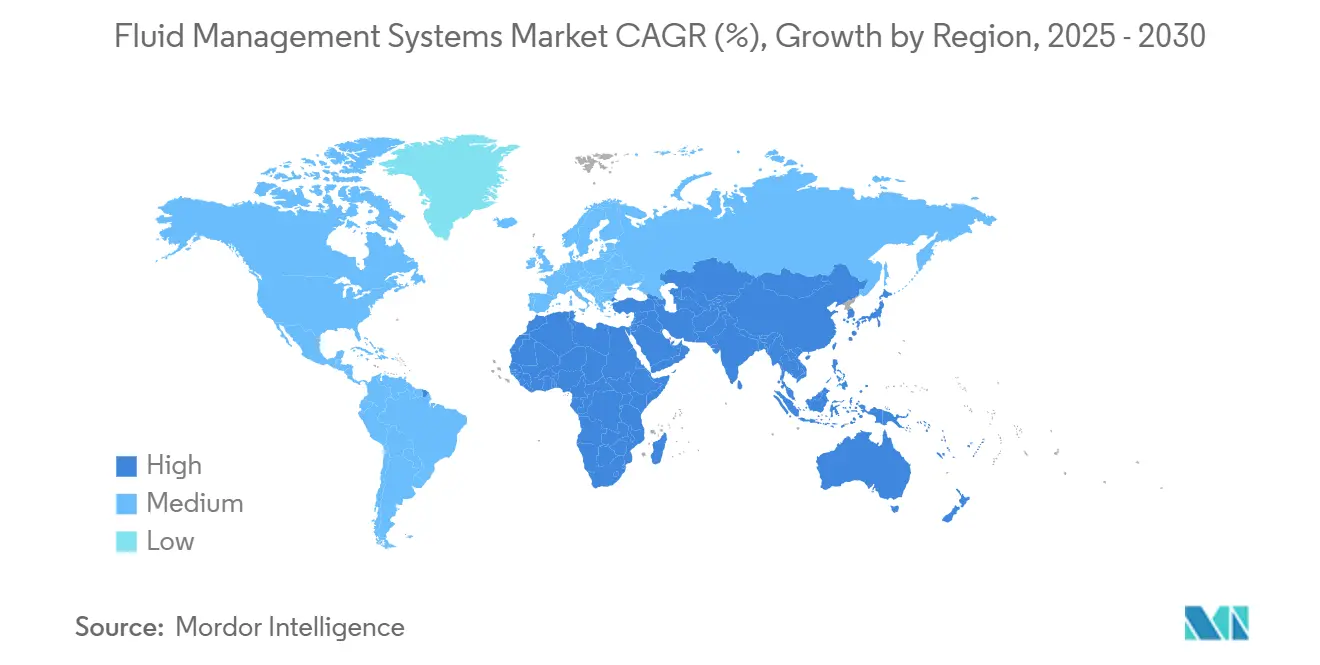
Competitive Landscape
The fluid management systems market features moderate fragmentation. Baxter, Medtronic, Fresenius Medical Care, and Johnson & Johnson occupy top tiers, leveraging deep R&D budgets to embed analytics within pumps and consoles. Baxter’s Novum IQ pump, cleared in 2024, integrates bidirectional EMR connectivity to reduce manual charting while enhancing dose accuracy. Medtronic recorded USD 33.5 billion FY25 revenue, with cardiovascular equipment up 6.6%, reflecting sustained demand for hemodynamic guidance.
Strategic M&A accelerates portfolio breadth. BD’s pending USD 4.2 billion purchase of Edwards Lifesciences’ Critical Care unit signals consolidation around data-rich monitoring assets. Teleflex’s EUR 760 million BIOTRONIK buy sharpens its vascular access lineup and captures synergy with existing catheter franchises.
Emerging competitors focus on home-dialysis wearables and AI decision-support layers. Breakthrough-device designation for a heparin-free dialysis circuit positions Fresenius to disrupt anticoagulation protocols and widen its moat against new entrants. Nevertheless, polymer shortages and single-use-plastic surcharges squeeze gross margins, pushing producers to invest in material science and dual sourcing.
Fluid Management Systems Industry Leaders
-
Baxter International Inc.
-
Smith & Nephew plc
-
Stryker Corporation
-
B. Braun Melsungen AG
-
Medtronic
- *Disclaimer: Major Players sorted in no particular order
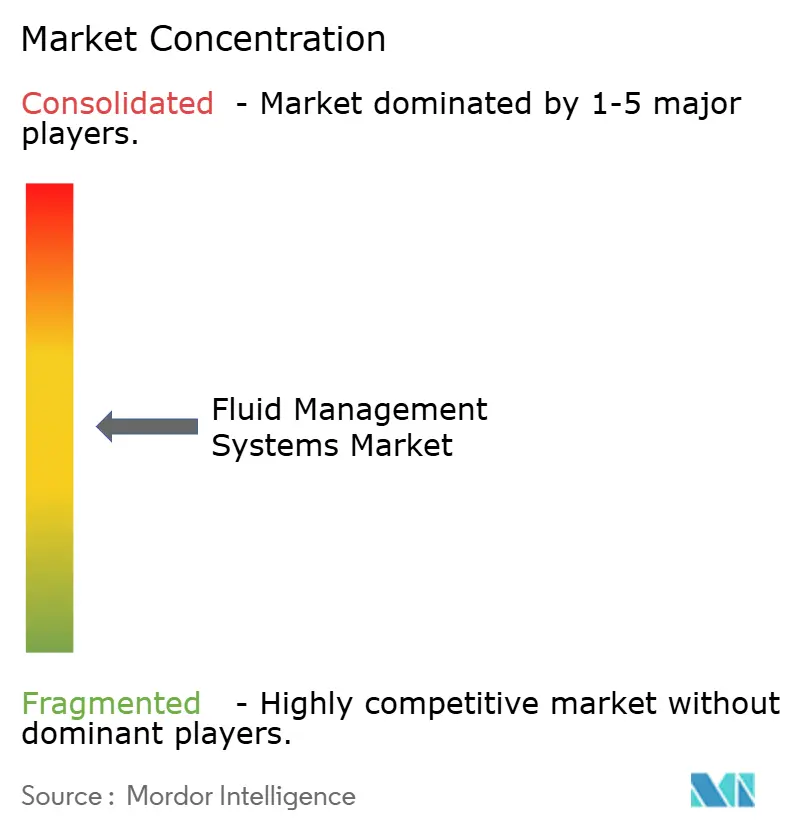


Recent Industry Developments
- June 2025: Boston Scientific launched the VARIPULSE Platform including catheter, generator, interface cable, and pump for treating paroxysmal atrial fibrillation through catheter ablation, with clinical studies showing 74.4% of patients experiencing no recurrence within 12 months
- May 2025: Medtronic reported strong fiscal year 2025 results with total revenue of USD 33.5 billion, a 3.6% increase, highlighting significant growth in its Cardiovascular Portfolio with Q4 revenue of USD 3.336 billion, up 6.6% year-over-year.
- April 2025: Teleflex received FDA 510(k) clearance for the AC3 Range Intra-Aortic Balloon Pump designed for reliable cardiac support during patient transport, featuring dual power options and full-size helium tank for transport challenges.
- April 2025: B. Braun Medical received FDA approval for Piperacillin and Tazobactam in its DUPLEX Drug Delivery System, reducing process time by nearly 4 minutes per dose and decreasing medication errors by 54% compared to traditional methods.
Research Methodology Framework and Report Scope
Market Definitions and Key Coverage
Mordor Intelligence defines the fluid management systems market as the global sales of hospital-grade equipment and single-use disposables that circulate, warm, suction, irrigate, or safely dispose of physiological fluids during dialysis, endoscopy, arthroscopy, urology, cardiology, and other surgical or diagnostic procedures.
Scope exclusion: Industrial fluid power devices and non-medical fluid transfer components are not tracked.
Segmentation Overview
- By Product
- Dialyzers
- Insufflators
- Suction & Irrigation Systems
- Fluid-Warming Devices
- Fluid-Waste Management
- Other Products
- By Disposables & Accessories
- Catheters
- Bloodlines
- Transducers
- Valves
- Tubing Sets
- Other Disposables
- By Application
- Arthroscopy
- Laparoscopy
- Neurology
- Cardiology
- Urology
- Dental
- Gastroenterology
- Other Applications
- By End User
- Hospitals
- Ambulatory Surgical Centers
- Dialysis Centers
- Specialty Clinics
- Home-Care Settings
- By Geography
- North America
- United States
- Canada
- Mexico
- Europe
- Germany
- United Kingdom
- France
- Italy
- Spain
- Rest of Europe
- Asia-Pacific
- China
- Japan
- India
- Australia
- South Korea
- Rest of Asia-Pacific
- Middle East & Africa
- GCC
- South Africa
- Rest of Middle East & Africa
- South America
- Brazil
- Argentina
- Rest of South America
- North America
Detailed Research Methodology and Data Validation
Primary Research
Surgeons, biomedical engineers, dialysis center directors, and hospital procurement leads across North America, Europe, Asia-Pacific, and the Middle East share current utilization rates, ASP movements, and emerging preferences. Their insights close data gaps and allow Mordor Intelligence to validate desktop findings before numbers are frozen.
Desk Research
Our analysts start with open datasets that quantify addressable demand, such as OECD and WHO surgery volumes, United States Renal Data System dialysis statistics, European Endoscopic Society procedure audits, and import-export filings sourced through UN Comtrade. Regulatory clearance logs from the FDA 510(k) database and CE-Mark listings help us map new model launches. For financial calibration, we pull supplier revenue splits from D&B Hoovers and scan Dow Jones Factiva, clinical journals, and leading trade-association white papers. These references illustrate, rather than exhaust, the full range of secondary inputs consulted.
Market-Sizing & Forecasting
We apply a top-down patient and procedure pool build, reconstructing demand from minimally invasive surgery counts, global hemodialysis prevalence, average consumables pull-through, and equipment replacement cycles. We then corroborate totals with selective bottom-up vendor revenue samplings and channel checks. Key variables include growth in day-care surgery centers, chronic kidney disease incidence, unit ASP deflation, regulatory approval tempo, and hospital cap-ex sentiment. Multivariate regression with scenario analysis projects these drivers through 2030; data voids in supplier roll-ups are bridged using region-specific ASP bands vetted during interviews.
Data Validation & Update Cycle
Outputs pass anomaly scans, year-over-year variance limits, and multi-analyst peer review. Reports refresh annually, while material events such as major recalls trigger interim updates; a final sense check is performed immediately before delivery.
Why Mordor's Fluid Management Systems Baseline Commands Reliability
Published market values often differ. They reflect dissimilar device baskets, currency assumptions, and refresh timetables.
Key gap drivers include whether disposables are included, how rapidly surgical procedure growth is rolled forward, and if exchange rates are frozen or blended. Mordor uses a 2025 baseline that captures both systems and single-use accessories and updates ASP curves every quarter, which some other publishers do not.
Benchmark comparison
| Market Size | Anonymized source | Primary gap driver |
|---|---|---|
| USD 14.1 B (2025) | Mordor Intelligence | - |
| USD 13.3 B (2025) | Global Consultancy A | narrower device list; static FX rate |
| USD 12.9 B (2024) | Industry Association B | disposables excluded; hospital spend proxy used |
| USD 8.92 B (2024) | Trade Journal C | limited regional coverage; surgery-only focus |
In sum, Mordor Intelligence pairs disciplined scope selection with live ASP tracking and dual-path validation, giving decision-makers a balanced, transparent baseline they can retrace and replicate with confidence.


Key Questions Answered in the Report
What is the current size of the fluid management systems market?
The market was valued at USD 14.11 billion in 2025 and is projected to reach USD 26.64 billion by 2030, reflecting a 13.58% CAGR.
Which region leads global sales?
North America generated 41.56% of 2024 revenue owing to advanced infrastructure and early AI adoption.
What segment represents the largest product share?
Dialyzers held 26.78% of 2024 revenue, driven by the high incidence of chronic kidney disease.
Where is the fastest growth expected?
Asia-Pacific is forecast to expand at a 14.98% CAGR through 2030 as healthcare spending and procedure volumes rise.
Why are home-care settings gaining importance?
Portable dialysis and remote monitoring technologies support self-care therapies, pushing home-care to a 14.98% CAGR over the forecast period.
What factors could restrain market expansion?
Surgeon shortages, high capital costs for integrated platforms, polymer price volatility, and single-use-plastic legislation may temper growth through 2030.
Page last updated on:








